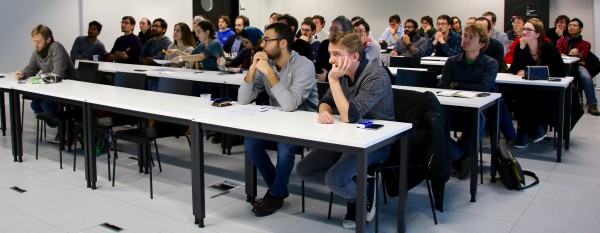MARVEL Junior Seminar — January 2020
The MARVEL Junior Seminars aim to intensify interactions between the MARVEL Junior scientists belonging to different research groups located at EPFL. The EPFL community interested in MARVEL research topics is very welcome to attend. We believe that these events will be central for establishing a vibrant community.
Each seminar consists of two presentations of 25 minutes each, allowing to present on a scientific question in depth, followed by time for discussion. The discussion is facilitated and timed by the chair.
Pizza is served at 11:45 in the MED hall (floor 0), and after the seminar at 13:30 you are cordially invited for coffee and dessert to continue discussion with the speakers.

MARVEL Junior Seminar Organizing Committee — Giuliana Materzanini, Stefano Falletta, Olga Syzgantseva, Maria Fumanal, Markus Stricker, Kristians Cernevics, Max Veit and Patrick Mayor
Abstract — Exploiting artificial neural networks in the simulation of acid catalysis
V. Jurásková1, K. Rossi2, L. Garel3, R. Wischert4, M. Ceriotti2, C. Corminboeuf1
1Laboratory for Computational Molecular Design (LCMD), EPFL
2Laboratory of Computational Science and Modeling (COSMO), EPFL
3Aroma Performance Laboratory, Solvay, RIC Lyon, France
4Ecco-Efficient Products and Processes Laboratory, Solvay, RIC Shanghai, China
The first principle simulations of chemical reactions in condensed phase involve a diversity of (charged) species that require both an accurate quantum chemical description (e.g., hybrid DFT) and a converged statistical sampling.Atomic potentials based on artificial neural networks (ANNs) have been increasingly used to simulate bulk materials, surface adsorption, gas phase reactions or aqueous solutions. ANNs are capable of describing high dimensional PES at the same accuracy as the reference quantum chemical method but at a fraction of their computational cost.
The present work introduces a simulation workflow based on ANN potentials trained on PBE0-D3BJ combined with a powerful multiple time step algorithm and enhanced sampling techniques. This approach, which is applied to a reactive mixture targeting the acid catalyzed hydroxylation of phenol, lead to achieve stable long-timescale molecular dynamics. Special emphasis is placed on the description and analysis of non-covalent interactions between the acid and the solvent for various related mixtures.
Abstract — First-principles simulations of transition-metal compounds using Hubbard-corrected density-functional (perturbation) theory
I. Timrov1, M. Cococcioni2, N. Marzari1
1Laboratory of theory and Simulation of Materials (THEOS), EPFL
2 Department of physics, University of Pavia, Italy
DFT+U and DFT+U+V are simple and powerful tools to model transition-metal compounds containing partially-filled manifolds of localized d and f states [1]. However, the Hubbard U (on-site) and V (inter-site) parameters are often treated semi-empirically, which is a somewhat unsatisfactory approach. Conceptual and practical methods to determine e.g. the Hubbard U parameter from first principles have nevertheless been introduced long ago, based either on the constrained random-phase approximation or on linear-response theory [2]. Nonetheless, these approaches are often overlooked due to their cost and/or complexity. Here, we introduce a computationally inexpensive and straightforward approach to determine on-site U and inter-site V [3], hitherto obtained from the difference between bare and self-consistent inverse electronic susceptibilities evaluated from supercell calculations. By recasting these calculations in the language of density-functional perturbation theory (DFPT) [4] we remove the need of supercells, and allow for a fully automated determination of Hubbard parameters. Such developments open the way for deployment in high-throughput studies, while providing the community with a simple tool to calculate consistent values of U and V for any system at hand. The approach has been implemented in the Quantum ESPRESSO package [5] and is showcased with applications to selected transition-metal compounds. Lastly, I will discuss the effect of Hubbard corrections on the calculation of formation energies of systems with defects [6], phonons [7], and near-edge X-ray absorption fine structure [8].
[1] V.I. Anisimov, J. Zaanen, O.K. Andersen, Phys. Rev. B 44, 943 (1991).
[2] M. Cococcioni and S. de Gironcoli, Phys. Rev. B 71, 035105 (2005).
[3] I. Timrov, N. Marzari and M. Cococcioni, Phys. Rev. B 98, 085127 (2018).
[4] S. Baroni, S. de Gironcoli, A. Dal Corso, P. Giannozzi, Rev. Mod. Phys. 73, 515 (2001).
[5] P. Giannozzi et al., J. Phys.: Condens. Matter 29, 465901 (2017).
[6] C. Ricca, I. Timrov, M. Cococcioni, N. Marzari, U. Aschauer, Phys. Rev. B 99, 094102 (2019).
[7] A. Floris, I. Timrov, B. Himmetoglu, S. de Gironcoli, N. Marzari, M. Cococcioni, submitted (2019); arXiv:1910.06195.
[8] I. Timrov, P. Agrawal, S. Erat, A. Braun, M. Cococcioni, M. Calandra, N. Marzari, D. Passerone, in preparation.
Check the list of the next MARVEL Junior Seminars here.
Low-volume newsletters, targeted to the scientific and industrial communities.
Subscribe to our newsletter